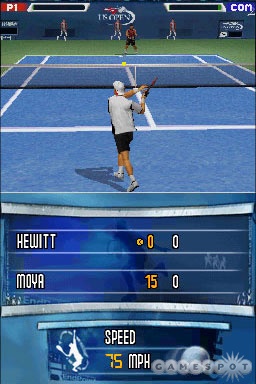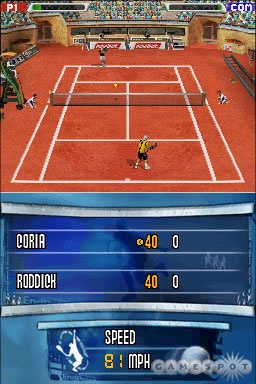Top Spin 2 for the Nintendo DS would keep most tennis fans satisfied for weeks, if only the herky-jerky graphics didn't render the game completely unplayable. The game's better aspects, such as its diverse player roster and deep shot system, aren't enough to compensate for a jumpy frame rate that makes it impossible to see and follow the ball.

Roger Federer and Maria Sharapova headline a roster that includes 16 actual male and female tennis pros. Ten different court locations are available, including a few real-world venues from tournaments such as Wimbledon, the US Open, and the Australian Open. Exhibition play can be waged against the CPU or you can compete against a friend wirelessly using two DS systems and two game cards. The other single-player modes are tournament and career. Career mode is set up like the similar modes found in other tennis games, where players create their own custom tennis phenom and gradually upgrade their skills by playing minigames and participating in tournaments.
Similar to the game's console counterparts, the controls and shot system in the DS version are easy to learn and layered with depth. The directional pad is used to control player movement, while the system buttons are used to input the various shot types. The touch screen is used only to navigate menus and rotate the world map in the career mode. Each of six different shot types is keyed to its own button on the unit. At the touch of a button, you can compel your onscreen persona to serve or return a flat, topspin, slice, lob, smash, or drop shot. In most cases, during the split-second that your player is winding up for his or her shot, you can hold the button longer to make a more powerful shot and use the D pad to target the shot toward a specific spot on the court. Whether a swing is a forehand or a backhand depends on which hand your player holds the racket in and which direction his or her body is facing relative to the ball. Righties, for example, will perform a forehand shot when the ball is to their right and a backhand shot when the ball is to their left. Control response is generally very quick, although you do have to make sure to let up on the button when you actually want your player to swing the racket. All in all, the shot system is easy to get the hang of and provides a great deal of control over the speed, arc, and placement of shots.
Four minigames in the career mode let you master the nuances of the shot system while upgrading your custom player's skills. Serve Sniper challenges you to hit targets on the opposite side of the net. Inflatable Carnage tests your ability to pop inflated targets with power shots. Shot Sequence is a Simon-style game where you have to hit sections on the other side of the net in the order shown. The last minigame, Tic Tac Toe, is a tennis-themed variation of the classic pen-and-paper game. Although other tennis video games typically offer a larger selection of minigames, the relative lack of selection here isn't a major shortfall because each game is conceptualized so well.
Sadly, all of the game's good aspects are made moot by the choppy graphical frame rate. The players don't return shots gracefully. Instead, they move in jerks, like some club kid performing the robot. The ball doesn't sail smoothly over the net. Instead, it literally disappears from one side of the net and reappears on the other side about halfway to the service line. Since the ball can't be seen until the last moment, it's impossible to track the ball's trajectory, which means you won't have time to move your player into position to make a return shot, let alone adjust the power and aim of the swing. Thus, the game is completely unplayable.

It's a shame that the frame rate is so bogus, because the remainder of the presentation is at least somewhat up to the task of portraying the sights and sounds that people expect from a tennis video game. The audio won't win any awards for artistry or variety, but the combination of realistic sound effects, recorded player grunts, and cheesy elevator music does back up the action relatively well. Visually, the graphics are somewhere between the Nintendo 64 and PlayStation in terms of quality, which is in line with what we've come to expect from the DS hardware. Player bodies are large and sufficiently detailed, and they look very much like actual people thanks to a relatively high polygon count and a believable implementation of shadow effects. The courts are necessarily plain, but the crisp graphics and behind-the-back camera perspective provide an ample sense of depth and place. In addition to the various court surfaces, prematch fly-bys help establish the setting by showing a 360-degree view of the venue and the spectators within. Even though spectators are immobile low-poly blobs, the overall appearance of the crowd suffices because they're only visible off in the distance during matches. Replays and reaction shots are infrequent, but they're nice to see when they occur.
In the end, unfortunately, the most important thing to keep in mind about Top Spin 2 for the Nintendo DS is that the jumpy frame rate makes it impossible to play the game for more than 30 seconds without inspiring the urge to smash the system into bits and pieces.